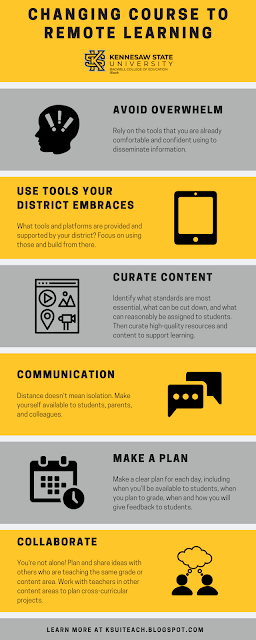Changing Course to Remote Learning
Three weeks ago, who could have guessed we’d be here? Everyone is in the same boat. I had plans to be preparing a baseball team for the state playoff push… It’s a different world. It’s overwhelming, we have to acknowledge that. My strategies tend to come down to lists of steps that I can check off, so here is a six-step protocol to working your way to online teaching:
You’re on your way now, keep growing your online teacher presence, you’re officially working from home!
- Don’t get overwhelmed: I know, easier said than done, and there are so many tools out there. You are experienced, and you have a peer or two who is experienced. Rely on the tools that you are already comfortably and confidently using to disseminate information. This isn’t the best time to learn the newest, it’s a time to perfect the known-est.
- Utilize the online management system that your school or district embraces: This stems from Step 1. You’ve been using something to stay in touch with kids at home all year, keep it up. Even if it starts with Remind, that’s a fantastic way to guide students through your class. This is not a one or two day deal, you’ll build your plans, but start where you are. You wouldn’t run a marathon on day one. We’re starting by doing a lap around the park you know.
Examples of places you might start: Remind, Edmodo, Schoology, Google Classroom, Microsoft Teams, ClassDojo, Seesaw, Bloomz - Curate good stuff: No matter how experienced you are, you have a ton of information in the form of PowerPoints, videos, worksheets, stories, textbooks, articles, texts, artifacts, and the list goes on. You have stuff. Some of it is fluff (I’ve done that Friday lesson before), but most of it is essential, I think. Figure out what’s most essential, where we can cut down, and what we can reasonably assign to students. This is the time to think about your district’s prioritized standards. What can you help them master from home? Keep in mind, students are just as overwhelmed. Give them things they can complete with confidence.
Great places to pull videos from: Crashcourse, TEDEd, Khan Academy, National Geographic, YouTube - Communicate with your kids and peers: Distance doesn’t mean isolation. Don’t go radio silent on your people. This is a great opportunity to have office hours during the day. Simply set up a room, and let your students know when you’re available to help. Go over the work you’ve assigned. This is a great chance to show humanity to your students. Don’t forget to reach out to some of your peers, too - if you need any help, or just need someone to vent to because it turns out your kids’ teachers aren’t exactly holding up their end of the bargain (Then share this post with them).
Places to have meetings: Google Hangouts Meet, Microsoft Teams, Zoom - Put a whole leg in: Develop a plan for each day, when you’ll be available to students, when you plan to grade, when and how you can give feedback without being within eyesight of your students. This is tough stuff, but it’s the work that matters. You’re in it now, and you’ve got this.
- We always need an extra: You feel great, now let the kids explore: Reach back out to your teacher friends (Step 4) who are teaching the same students, see if you can inspire your kids to do an exploratory project where they could get multiple grades in multiple subjects. English grade for research and a paper, science grade for content, WHAT?!
You’re on your way now, keep growing your online teacher presence, you’re officially working from home!
Contributing coach Max Gertz



Comments
Post a Comment